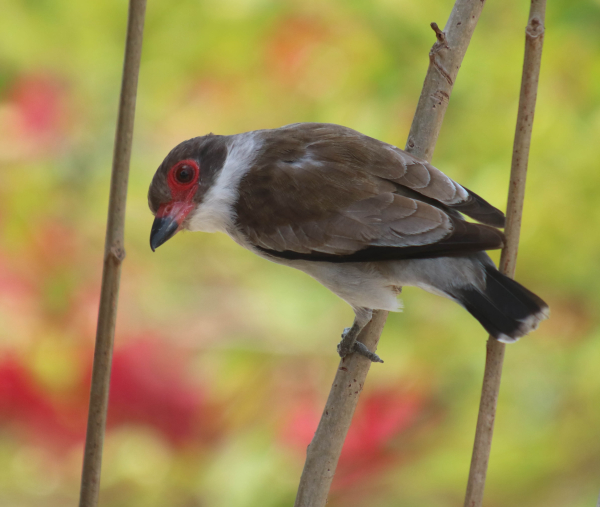
Among the estimated 50 billion birds in the world, a Masked Tityra forages in the Mexican Yucatan (photo by Paul Konrad).
Attachments area
|
There are roughly 50 billion birds in the world according to a new “big data study” by University of New South Wales (UNSW) in Sydney, the first of its kind, that indicated there are about 6 birds for every human on the planet. The study was based on almost a billion bird sightings submitted by birders from around the world to eBird, and it will be published this week in the Proceedings of the National Academy of Sciences. This is the first comprehensive effort to estimate all the birds in our world.
“Humans have spent a great deal of effort counting the members of our own species - all 7.8 billion of us,” said Associate Professor Will Cornwell, an ecologist at UNSW and co-senior author of the study. “This is the first comprehensive effort to estimate a suite of other species – Birds.” The research team pooling together almost a billion bird sightings logged on eBird, an online database of bird observations by birders. Using this basic data, and adding detailed case studies where available, they developed an algorithm to estimate the actual global population of each bird species.
This calculation took into account each species’ “detectability;” that is, how likely it is that a person will have spotted this bird and submitted the sighting to eBird. Detectability can include factors like their size, color, whether they fly in flocks, and if they live close to cities. “While this study focuses on birds, our large-scale data approach could act as a blueprint for calculating species-specific abundance for other groups of animals,” said the study’s lead author, Dr. Corey Callaghan, who completed the research while he was a postdoctoral researcher at UNSW.
“Quantifying the abundance of a species is a crucial first step in conservation. By properly estimating species abundance, we learn what species might be vulnerable and can track how these patterns change over time. In other words, we can better understand our baselines,” Callaghan explained. The study dataset includes records for almost all bird species (92 percent). However, the researchers say it’s unlikely the remaining 8 percent, which were excluded for being so rare that we lacked available data, would have much impact on the overall estimate.
Only 4 bird species belonged to what the researchers call “the billion club” - species with an estimated global population of over a billion: House Sparrows (1.6 billion) head this exclusive group, which also includes European Starlings (1.3 billion), Ring-billed Gulls (1.2 billion), and Barn Swallows (1.1 billion). “It was surprising that only a few species dominate the total number of individual birds in the world,” said Dr. Callaghan, who is now based at the German Centre for Integrative Biodiversity Research. “What is it about those species, evolutionarily, that has made them so hyper-successful?”
While some bird populations are thriving, many others appear to be a lot smaller: About 12 percent of bird species included in the study have an estimated population of less than 5,000. “We'll be able to tell how these species are faring by repeating the study in 5 or 10 years,” noted Professor Cornwell. “If their population numbers decline, it could be a real alarm bell for the health of our ecosystems.”
A Global Effort
The study was made possible with the help of more than 600,000 birders who contributed their sightings to the eBird dataset from 2010 to 2019. The Cornell Lab of Ornithology operates the eBird site and have made the data freely available.
“Large global citizen science databases such as eBird are revolutionizing our ability to study macro-ecology,” explained Professor Cornwell. “This type of data simply wasn’t available a decade ago.” While the research team is confident about their estimates, they acknowledge a degree of uncertainty is inevitable when working with large datasets like this. For example, people who document their sightings may be more likely to seek out rare species, or a species may be so rare that there simply isn’t enough data.
“A range of uncertainty is necessary when making global-level estimates,” said Professor Shinichi Nakagawa, an ecologist and statistician at UNSW and co-senior author of the publication. “Our findings, while rough in some areas, represent the best available data we currently have for many species.” New data is continuously added to eBird from both past records and present-day sightings. The research team plan to repeat their analysis as more data becomes available. “We will need to repeat and refine this effort to really keep tabs on biodiversity - especially as human-caused changes to the world continue and intensify,” noted Dr. Callaghan.
Birding is a popular hobby that dates back to the late 18th Century. The growing popularity of birding apps and websites have made birding an accessible way to engage with science. “Birding is a hobby that just keeps on giving,” said Callaghan. “You can usually find a bird or 2 to identify and watch anywhere you go, anytime of the day, anywhere in the world.” People interested in being involved with the project can create an account on eBird, and Professor Cornwell explained that you don't need to be a bird expert to get started.
To refer to the original information provided by the University of New South Wales to ScienceDaily, see https://www.sciencedaily.com/releases/2021/05/210517194658.htm